PUBH6210: Constructing a Study Design on Death and Dying in Aged Care
VerifiedAdded on 2023/04/25
|8
|2508
|55
Report
AI Summary
This assignment presents a research study design investigating death and dying in residential aged care facilities. It includes both qualitative and quantitative research questions, focusing on the views and experiences of staff members, including nurse assistants and registered nurses, regarding the death of older people. The study design details the methodology, setting, and sample for both qualitative (interviews and focus group discussions) and quantitative (survey) approaches, outlining data collection methods and statistical analysis techniques. Ethical considerations, such as confidentiality and informed consent, are also addressed to ensure the well-being of participants. The goal is to understand the positive and negative perceptions of staff towards death and dying, and their coping strategies in providing end-of-life care.
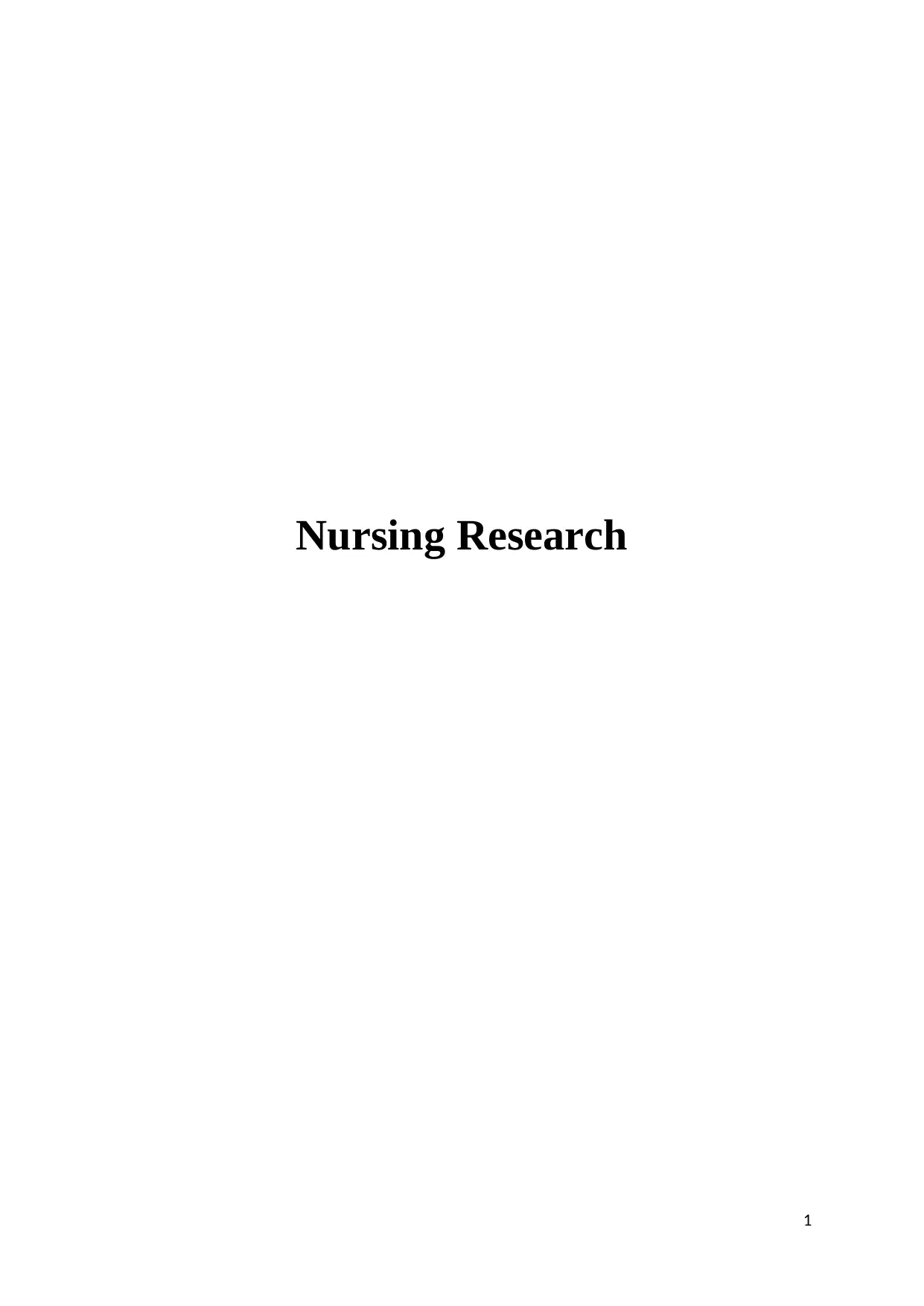
Nursing Research
1
1
Paraphrase This Document
Need a fresh take? Get an instant paraphrase of this document with our AI Paraphraser
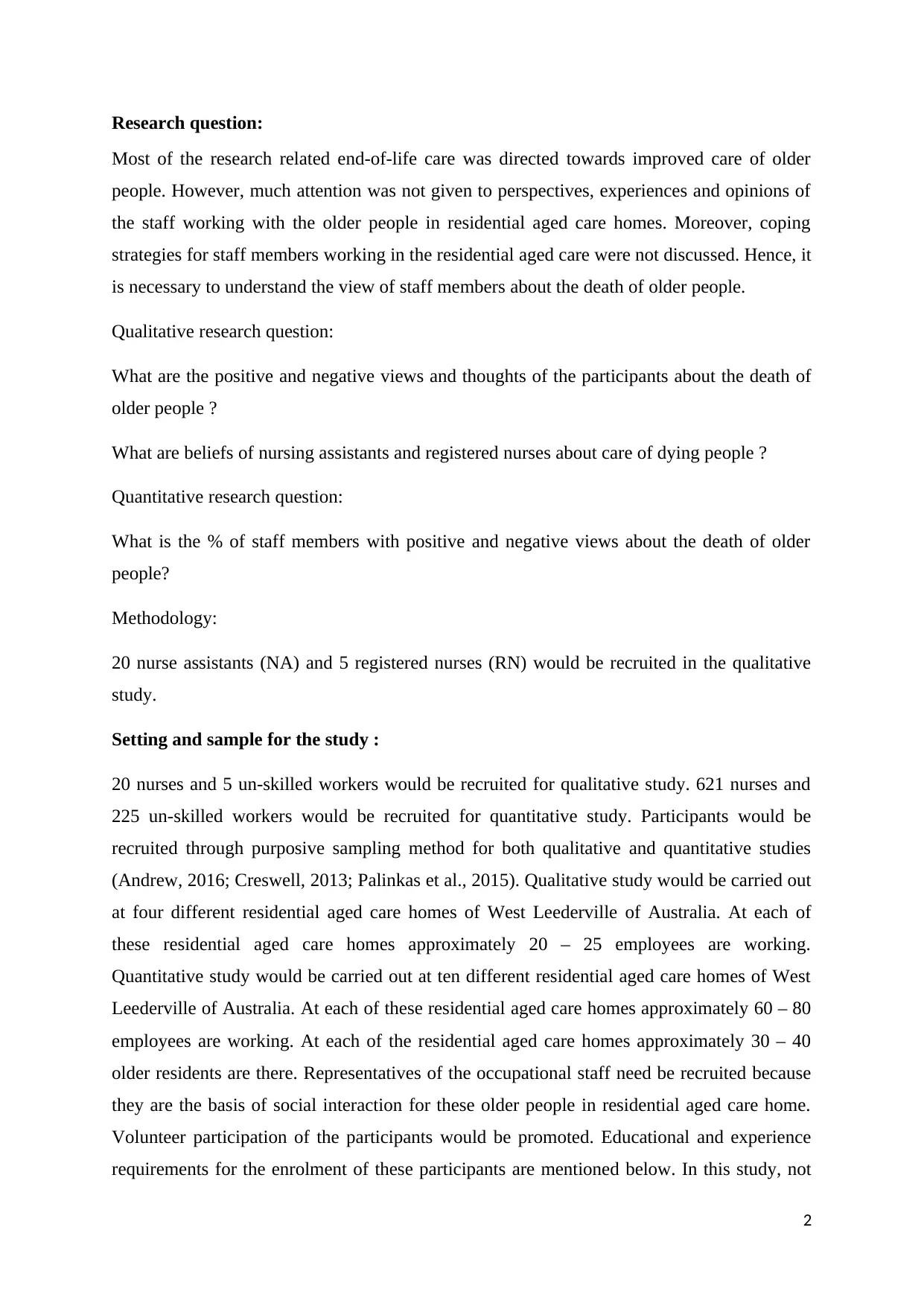
Research question:
Most of the research related end-of-life care was directed towards improved care of older
people. However, much attention was not given to perspectives, experiences and opinions of
the staff working with the older people in residential aged care homes. Moreover, coping
strategies for staff members working in the residential aged care were not discussed. Hence, it
is necessary to understand the view of staff members about the death of older people.
Qualitative research question:
What are the positive and negative views and thoughts of the participants about the death of
older people ?
What are beliefs of nursing assistants and registered nurses about care of dying people ?
Quantitative research question:
What is the % of staff members with positive and negative views about the death of older
people?
Methodology:
20 nurse assistants (NA) and 5 registered nurses (RN) would be recruited in the qualitative
study.
Setting and sample for the study :
20 nurses and 5 un-skilled workers would be recruited for qualitative study. 621 nurses and
225 un-skilled workers would be recruited for quantitative study. Participants would be
recruited through purposive sampling method for both qualitative and quantitative studies
(Andrew, 2016; Creswell, 2013; Palinkas et al., 2015). Qualitative study would be carried out
at four different residential aged care homes of West Leederville of Australia. At each of
these residential aged care homes approximately 20 – 25 employees are working.
Quantitative study would be carried out at ten different residential aged care homes of West
Leederville of Australia. At each of these residential aged care homes approximately 60 – 80
employees are working. At each of the residential aged care homes approximately 30 – 40
older residents are there. Representatives of the occupational staff need be recruited because
they are the basis of social interaction for these older people in residential aged care home.
Volunteer participation of the participants would be promoted. Educational and experience
requirements for the enrolment of these participants are mentioned below. In this study, not
2
Most of the research related end-of-life care was directed towards improved care of older
people. However, much attention was not given to perspectives, experiences and opinions of
the staff working with the older people in residential aged care homes. Moreover, coping
strategies for staff members working in the residential aged care were not discussed. Hence, it
is necessary to understand the view of staff members about the death of older people.
Qualitative research question:
What are the positive and negative views and thoughts of the participants about the death of
older people ?
What are beliefs of nursing assistants and registered nurses about care of dying people ?
Quantitative research question:
What is the % of staff members with positive and negative views about the death of older
people?
Methodology:
20 nurse assistants (NA) and 5 registered nurses (RN) would be recruited in the qualitative
study.
Setting and sample for the study :
20 nurses and 5 un-skilled workers would be recruited for qualitative study. 621 nurses and
225 un-skilled workers would be recruited for quantitative study. Participants would be
recruited through purposive sampling method for both qualitative and quantitative studies
(Andrew, 2016; Creswell, 2013; Palinkas et al., 2015). Qualitative study would be carried out
at four different residential aged care homes of West Leederville of Australia. At each of
these residential aged care homes approximately 20 – 25 employees are working.
Quantitative study would be carried out at ten different residential aged care homes of West
Leederville of Australia. At each of these residential aged care homes approximately 60 – 80
employees are working. At each of the residential aged care homes approximately 30 – 40
older residents are there. Representatives of the occupational staff need be recruited because
they are the basis of social interaction for these older people in residential aged care home.
Volunteer participation of the participants would be promoted. Educational and experience
requirements for the enrolment of these participants are mentioned below. In this study, not
2
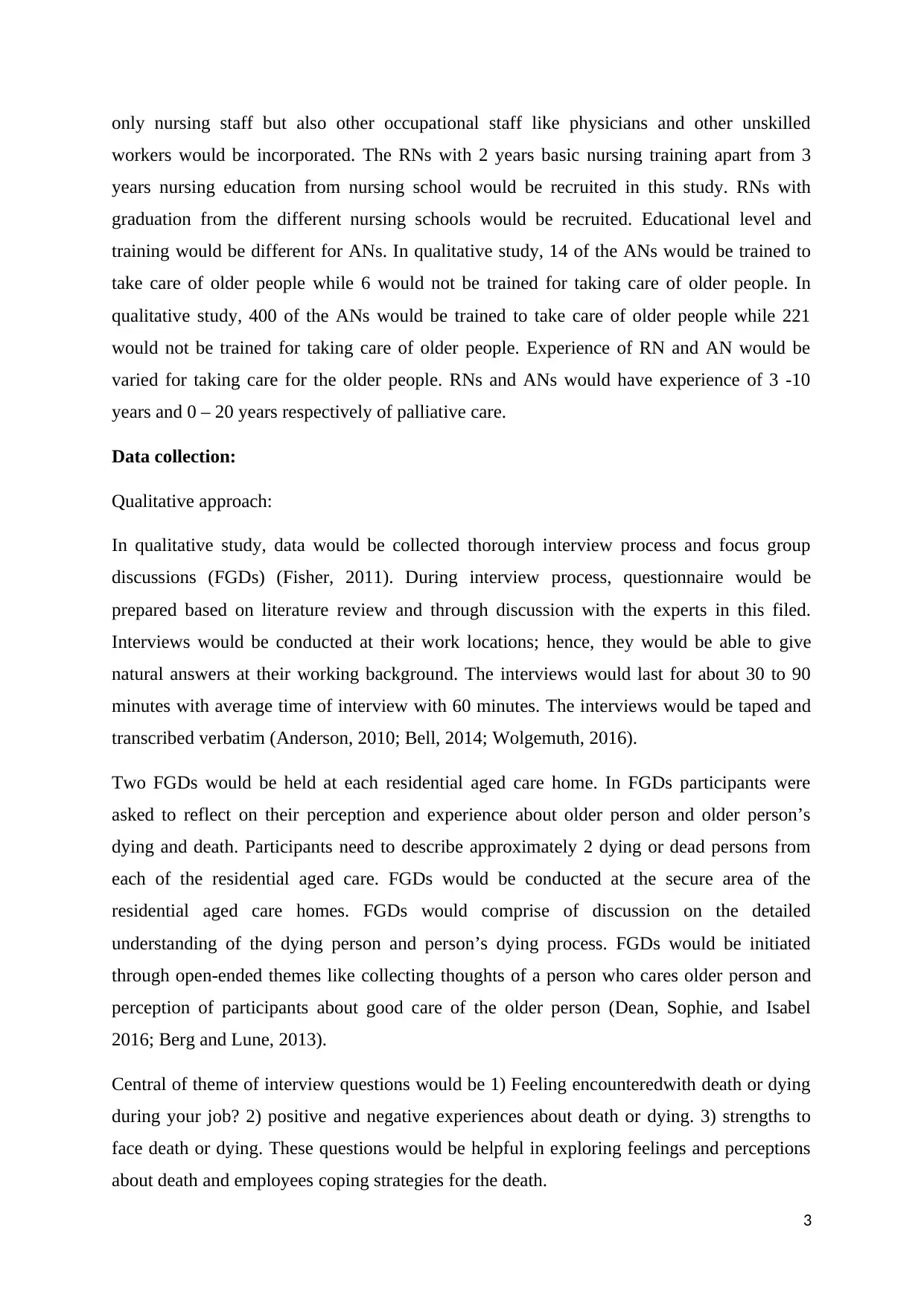
only nursing staff but also other occupational staff like physicians and other unskilled
workers would be incorporated. The RNs with 2 years basic nursing training apart from 3
years nursing education from nursing school would be recruited in this study. RNs with
graduation from the different nursing schools would be recruited. Educational level and
training would be different for ANs. In qualitative study, 14 of the ANs would be trained to
take care of older people while 6 would not be trained for taking care of older people. In
qualitative study, 400 of the ANs would be trained to take care of older people while 221
would not be trained for taking care of older people. Experience of RN and AN would be
varied for taking care for the older people. RNs and ANs would have experience of 3 -10
years and 0 – 20 years respectively of palliative care.
Data collection:
Qualitative approach:
In qualitative study, data would be collected thorough interview process and focus group
discussions (FGDs) (Fisher, 2011). During interview process, questionnaire would be
prepared based on literature review and through discussion with the experts in this filed.
Interviews would be conducted at their work locations; hence, they would be able to give
natural answers at their working background. The interviews would last for about 30 to 90
minutes with average time of interview with 60 minutes. The interviews would be taped and
transcribed verbatim (Anderson, 2010; Bell, 2014; Wolgemuth, 2016).
Two FGDs would be held at each residential aged care home. In FGDs participants were
asked to reflect on their perception and experience about older person and older person’s
dying and death. Participants need to describe approximately 2 dying or dead persons from
each of the residential aged care. FGDs would be conducted at the secure area of the
residential aged care homes. FGDs would comprise of discussion on the detailed
understanding of the dying person and person’s dying process. FGDs would be initiated
through open-ended themes like collecting thoughts of a person who cares older person and
perception of participants about good care of the older person (Dean, Sophie, and Isabel
2016; Berg and Lune, 2013).
Central of theme of interview questions would be 1) Feeling encounteredwith death or dying
during your job? 2) positive and negative experiences about death or dying. 3) strengths to
face death or dying. These questions would be helpful in exploring feelings and perceptions
about death and employees coping strategies for the death.
3
workers would be incorporated. The RNs with 2 years basic nursing training apart from 3
years nursing education from nursing school would be recruited in this study. RNs with
graduation from the different nursing schools would be recruited. Educational level and
training would be different for ANs. In qualitative study, 14 of the ANs would be trained to
take care of older people while 6 would not be trained for taking care of older people. In
qualitative study, 400 of the ANs would be trained to take care of older people while 221
would not be trained for taking care of older people. Experience of RN and AN would be
varied for taking care for the older people. RNs and ANs would have experience of 3 -10
years and 0 – 20 years respectively of palliative care.
Data collection:
Qualitative approach:
In qualitative study, data would be collected thorough interview process and focus group
discussions (FGDs) (Fisher, 2011). During interview process, questionnaire would be
prepared based on literature review and through discussion with the experts in this filed.
Interviews would be conducted at their work locations; hence, they would be able to give
natural answers at their working background. The interviews would last for about 30 to 90
minutes with average time of interview with 60 minutes. The interviews would be taped and
transcribed verbatim (Anderson, 2010; Bell, 2014; Wolgemuth, 2016).
Two FGDs would be held at each residential aged care home. In FGDs participants were
asked to reflect on their perception and experience about older person and older person’s
dying and death. Participants need to describe approximately 2 dying or dead persons from
each of the residential aged care. FGDs would be conducted at the secure area of the
residential aged care homes. FGDs would comprise of discussion on the detailed
understanding of the dying person and person’s dying process. FGDs would be initiated
through open-ended themes like collecting thoughts of a person who cares older person and
perception of participants about good care of the older person (Dean, Sophie, and Isabel
2016; Berg and Lune, 2013).
Central of theme of interview questions would be 1) Feeling encounteredwith death or dying
during your job? 2) positive and negative experiences about death or dying. 3) strengths to
face death or dying. These questions would be helpful in exploring feelings and perceptions
about death and employees coping strategies for the death.
3
⊘ This is a preview!⊘
Do you want full access?
Subscribe today to unlock all pages.

Trusted by 1+ million students worldwide
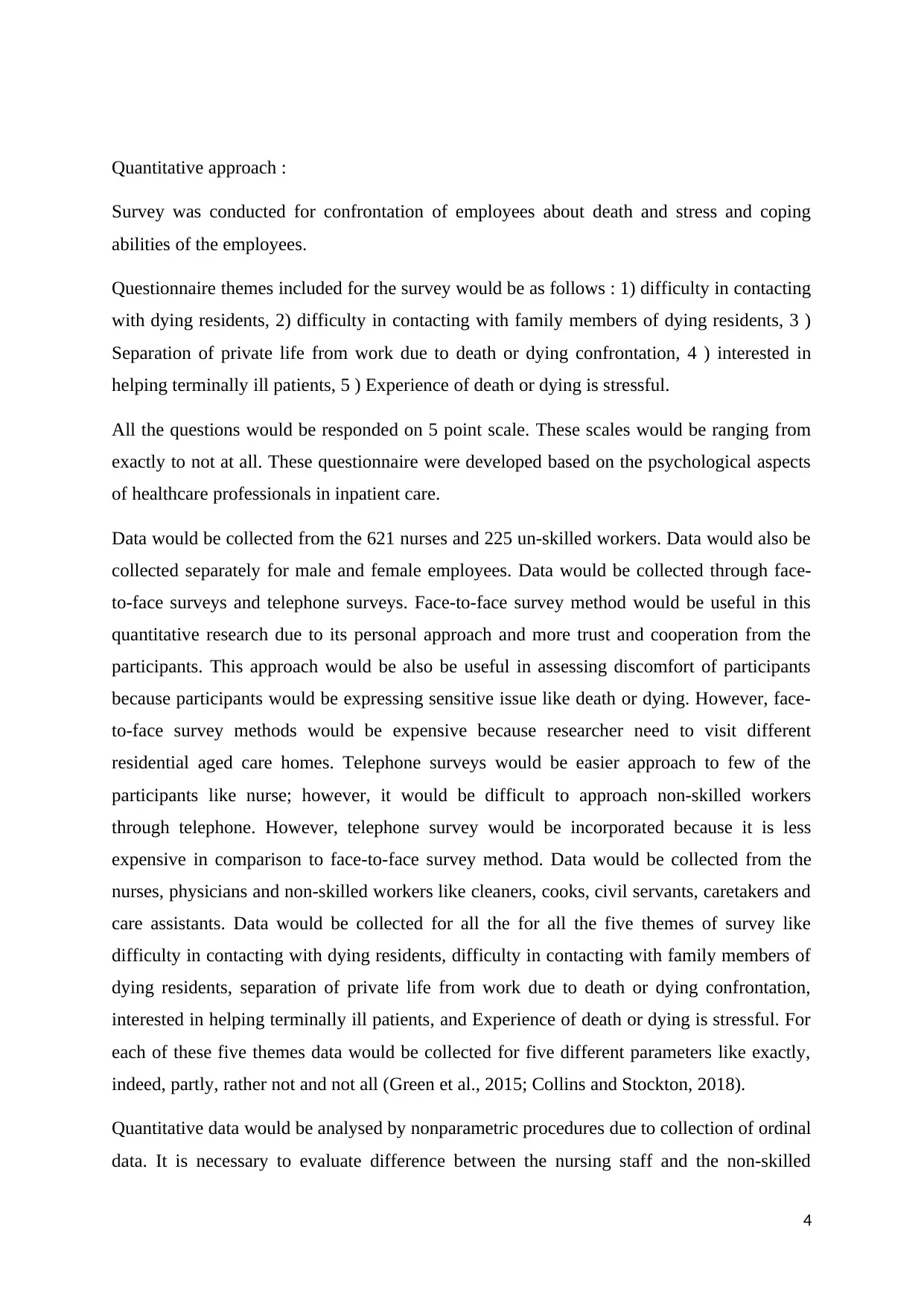
Quantitative approach :
Survey was conducted for confrontation of employees about death and stress and coping
abilities of the employees.
Questionnaire themes included for the survey would be as follows : 1) difficulty in contacting
with dying residents, 2) difficulty in contacting with family members of dying residents, 3 )
Separation of private life from work due to death or dying confrontation, 4 ) interested in
helping terminally ill patients, 5 ) Experience of death or dying is stressful.
All the questions would be responded on 5 point scale. These scales would be ranging from
exactly to not at all. These questionnaire were developed based on the psychological aspects
of healthcare professionals in inpatient care.
Data would be collected from the 621 nurses and 225 un-skilled workers. Data would also be
collected separately for male and female employees. Data would be collected through face-
to-face surveys and telephone surveys. Face-to-face survey method would be useful in this
quantitative research due to its personal approach and more trust and cooperation from the
participants. This approach would be also be useful in assessing discomfort of participants
because participants would be expressing sensitive issue like death or dying. However, face-
to-face survey methods would be expensive because researcher need to visit different
residential aged care homes. Telephone surveys would be easier approach to few of the
participants like nurse; however, it would be difficult to approach non-skilled workers
through telephone. However, telephone survey would be incorporated because it is less
expensive in comparison to face-to-face survey method. Data would be collected from the
nurses, physicians and non-skilled workers like cleaners, cooks, civil servants, caretakers and
care assistants. Data would be collected for all the for all the five themes of survey like
difficulty in contacting with dying residents, difficulty in contacting with family members of
dying residents, separation of private life from work due to death or dying confrontation,
interested in helping terminally ill patients, and Experience of death or dying is stressful. For
each of these five themes data would be collected for five different parameters like exactly,
indeed, partly, rather not and not all (Green et al., 2015; Collins and Stockton, 2018).
Quantitative data would be analysed by nonparametric procedures due to collection of ordinal
data. It is necessary to evaluate difference between the nursing staff and the non-skilled
4
Survey was conducted for confrontation of employees about death and stress and coping
abilities of the employees.
Questionnaire themes included for the survey would be as follows : 1) difficulty in contacting
with dying residents, 2) difficulty in contacting with family members of dying residents, 3 )
Separation of private life from work due to death or dying confrontation, 4 ) interested in
helping terminally ill patients, 5 ) Experience of death or dying is stressful.
All the questions would be responded on 5 point scale. These scales would be ranging from
exactly to not at all. These questionnaire were developed based on the psychological aspects
of healthcare professionals in inpatient care.
Data would be collected from the 621 nurses and 225 un-skilled workers. Data would also be
collected separately for male and female employees. Data would be collected through face-
to-face surveys and telephone surveys. Face-to-face survey method would be useful in this
quantitative research due to its personal approach and more trust and cooperation from the
participants. This approach would be also be useful in assessing discomfort of participants
because participants would be expressing sensitive issue like death or dying. However, face-
to-face survey methods would be expensive because researcher need to visit different
residential aged care homes. Telephone surveys would be easier approach to few of the
participants like nurse; however, it would be difficult to approach non-skilled workers
through telephone. However, telephone survey would be incorporated because it is less
expensive in comparison to face-to-face survey method. Data would be collected from the
nurses, physicians and non-skilled workers like cleaners, cooks, civil servants, caretakers and
care assistants. Data would be collected for all the for all the five themes of survey like
difficulty in contacting with dying residents, difficulty in contacting with family members of
dying residents, separation of private life from work due to death or dying confrontation,
interested in helping terminally ill patients, and Experience of death or dying is stressful. For
each of these five themes data would be collected for five different parameters like exactly,
indeed, partly, rather not and not all (Green et al., 2015; Collins and Stockton, 2018).
Quantitative data would be analysed by nonparametric procedures due to collection of ordinal
data. It is necessary to evaluate difference between the nursing staff and the non-skilled
4
Paraphrase This Document
Need a fresh take? Get an instant paraphrase of this document with our AI Paraphraser
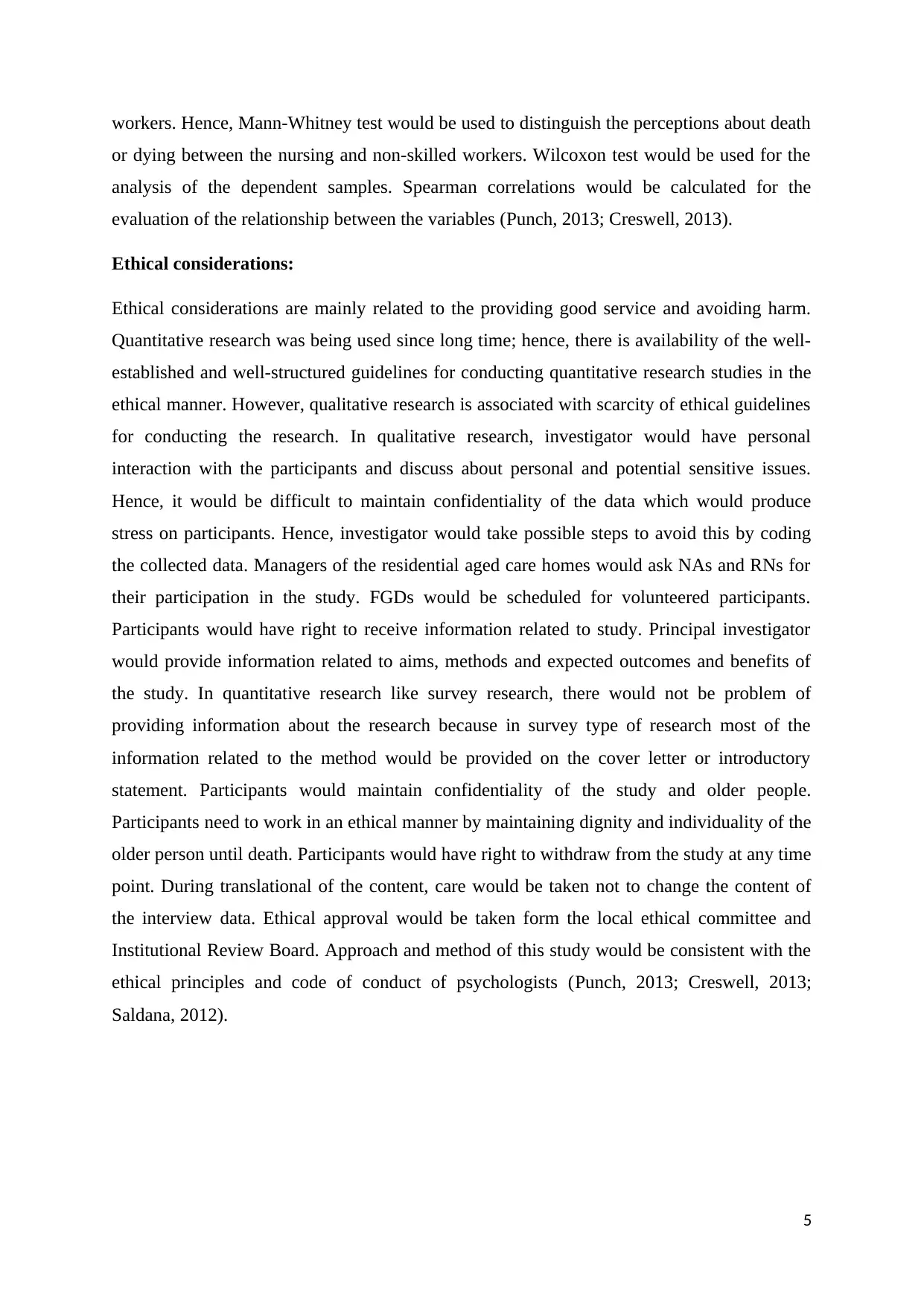
workers. Hence, Mann-Whitney test would be used to distinguish the perceptions about death
or dying between the nursing and non-skilled workers. Wilcoxon test would be used for the
analysis of the dependent samples. Spearman correlations would be calculated for the
evaluation of the relationship between the variables (Punch, 2013; Creswell, 2013).
Ethical considerations:
Ethical considerations are mainly related to the providing good service and avoiding harm.
Quantitative research was being used since long time; hence, there is availability of the well-
established and well-structured guidelines for conducting quantitative research studies in the
ethical manner. However, qualitative research is associated with scarcity of ethical guidelines
for conducting the research. In qualitative research, investigator would have personal
interaction with the participants and discuss about personal and potential sensitive issues.
Hence, it would be difficult to maintain confidentiality of the data which would produce
stress on participants. Hence, investigator would take possible steps to avoid this by coding
the collected data. Managers of the residential aged care homes would ask NAs and RNs for
their participation in the study. FGDs would be scheduled for volunteered participants.
Participants would have right to receive information related to study. Principal investigator
would provide information related to aims, methods and expected outcomes and benefits of
the study. In quantitative research like survey research, there would not be problem of
providing information about the research because in survey type of research most of the
information related to the method would be provided on the cover letter or introductory
statement. Participants would maintain confidentiality of the study and older people.
Participants need to work in an ethical manner by maintaining dignity and individuality of the
older person until death. Participants would have right to withdraw from the study at any time
point. During translational of the content, care would be taken not to change the content of
the interview data. Ethical approval would be taken form the local ethical committee and
Institutional Review Board. Approach and method of this study would be consistent with the
ethical principles and code of conduct of psychologists (Punch, 2013; Creswell, 2013;
Saldana, 2012).
5
or dying between the nursing and non-skilled workers. Wilcoxon test would be used for the
analysis of the dependent samples. Spearman correlations would be calculated for the
evaluation of the relationship between the variables (Punch, 2013; Creswell, 2013).
Ethical considerations:
Ethical considerations are mainly related to the providing good service and avoiding harm.
Quantitative research was being used since long time; hence, there is availability of the well-
established and well-structured guidelines for conducting quantitative research studies in the
ethical manner. However, qualitative research is associated with scarcity of ethical guidelines
for conducting the research. In qualitative research, investigator would have personal
interaction with the participants and discuss about personal and potential sensitive issues.
Hence, it would be difficult to maintain confidentiality of the data which would produce
stress on participants. Hence, investigator would take possible steps to avoid this by coding
the collected data. Managers of the residential aged care homes would ask NAs and RNs for
their participation in the study. FGDs would be scheduled for volunteered participants.
Participants would have right to receive information related to study. Principal investigator
would provide information related to aims, methods and expected outcomes and benefits of
the study. In quantitative research like survey research, there would not be problem of
providing information about the research because in survey type of research most of the
information related to the method would be provided on the cover letter or introductory
statement. Participants would maintain confidentiality of the study and older people.
Participants need to work in an ethical manner by maintaining dignity and individuality of the
older person until death. Participants would have right to withdraw from the study at any time
point. During translational of the content, care would be taken not to change the content of
the interview data. Ethical approval would be taken form the local ethical committee and
Institutional Review Board. Approach and method of this study would be consistent with the
ethical principles and code of conduct of psychologists (Punch, 2013; Creswell, 2013;
Saldana, 2012).
5
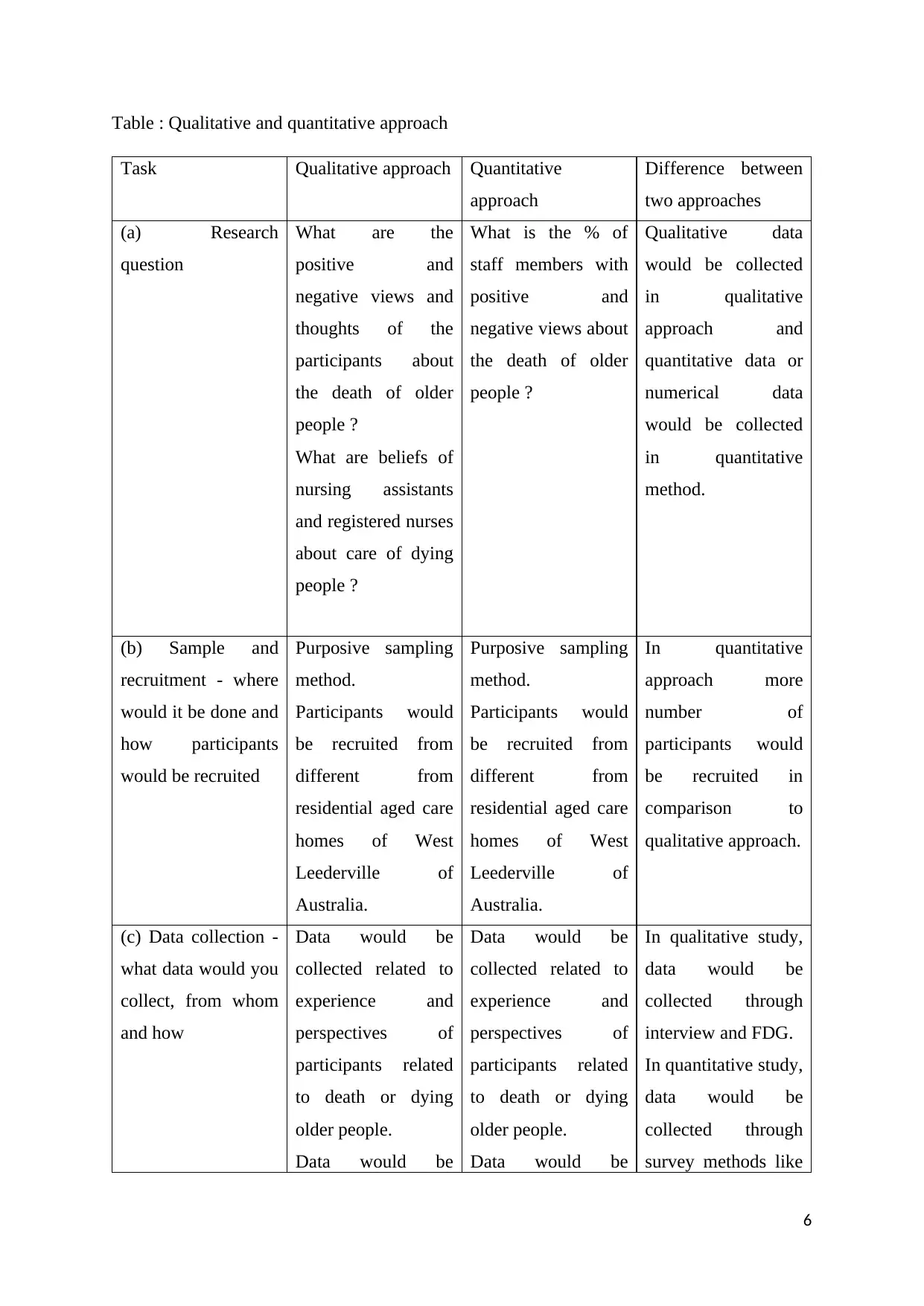
Table : Qualitative and quantitative approach
Task Qualitative approach Quantitative
approach
Difference between
two approaches
(a) Research
question
What are the
positive and
negative views and
thoughts of the
participants about
the death of older
people ?
What are beliefs of
nursing assistants
and registered nurses
about care of dying
people ?
What is the % of
staff members with
positive and
negative views about
the death of older
people ?
Qualitative data
would be collected
in qualitative
approach and
quantitative data or
numerical data
would be collected
in quantitative
method.
(b) Sample and
recruitment - where
would it be done and
how participants
would be recruited
Purposive sampling
method.
Participants would
be recruited from
different from
residential aged care
homes of West
Leederville of
Australia.
Purposive sampling
method.
Participants would
be recruited from
different from
residential aged care
homes of West
Leederville of
Australia.
In quantitative
approach more
number of
participants would
be recruited in
comparison to
qualitative approach.
(c) Data collection -
what data would you
collect, from whom
and how
Data would be
collected related to
experience and
perspectives of
participants related
to death or dying
older people.
Data would be
Data would be
collected related to
experience and
perspectives of
participants related
to death or dying
older people.
Data would be
In qualitative study,
data would be
collected through
interview and FDG.
In quantitative study,
data would be
collected through
survey methods like
6
Task Qualitative approach Quantitative
approach
Difference between
two approaches
(a) Research
question
What are the
positive and
negative views and
thoughts of the
participants about
the death of older
people ?
What are beliefs of
nursing assistants
and registered nurses
about care of dying
people ?
What is the % of
staff members with
positive and
negative views about
the death of older
people ?
Qualitative data
would be collected
in qualitative
approach and
quantitative data or
numerical data
would be collected
in quantitative
method.
(b) Sample and
recruitment - where
would it be done and
how participants
would be recruited
Purposive sampling
method.
Participants would
be recruited from
different from
residential aged care
homes of West
Leederville of
Australia.
Purposive sampling
method.
Participants would
be recruited from
different from
residential aged care
homes of West
Leederville of
Australia.
In quantitative
approach more
number of
participants would
be recruited in
comparison to
qualitative approach.
(c) Data collection -
what data would you
collect, from whom
and how
Data would be
collected related to
experience and
perspectives of
participants related
to death or dying
older people.
Data would be
Data would be
collected related to
experience and
perspectives of
participants related
to death or dying
older people.
Data would be
In qualitative study,
data would be
collected through
interview and FDG.
In quantitative study,
data would be
collected through
survey methods like
6
⊘ This is a preview!⊘
Do you want full access?
Subscribe today to unlock all pages.

Trusted by 1+ million students worldwide
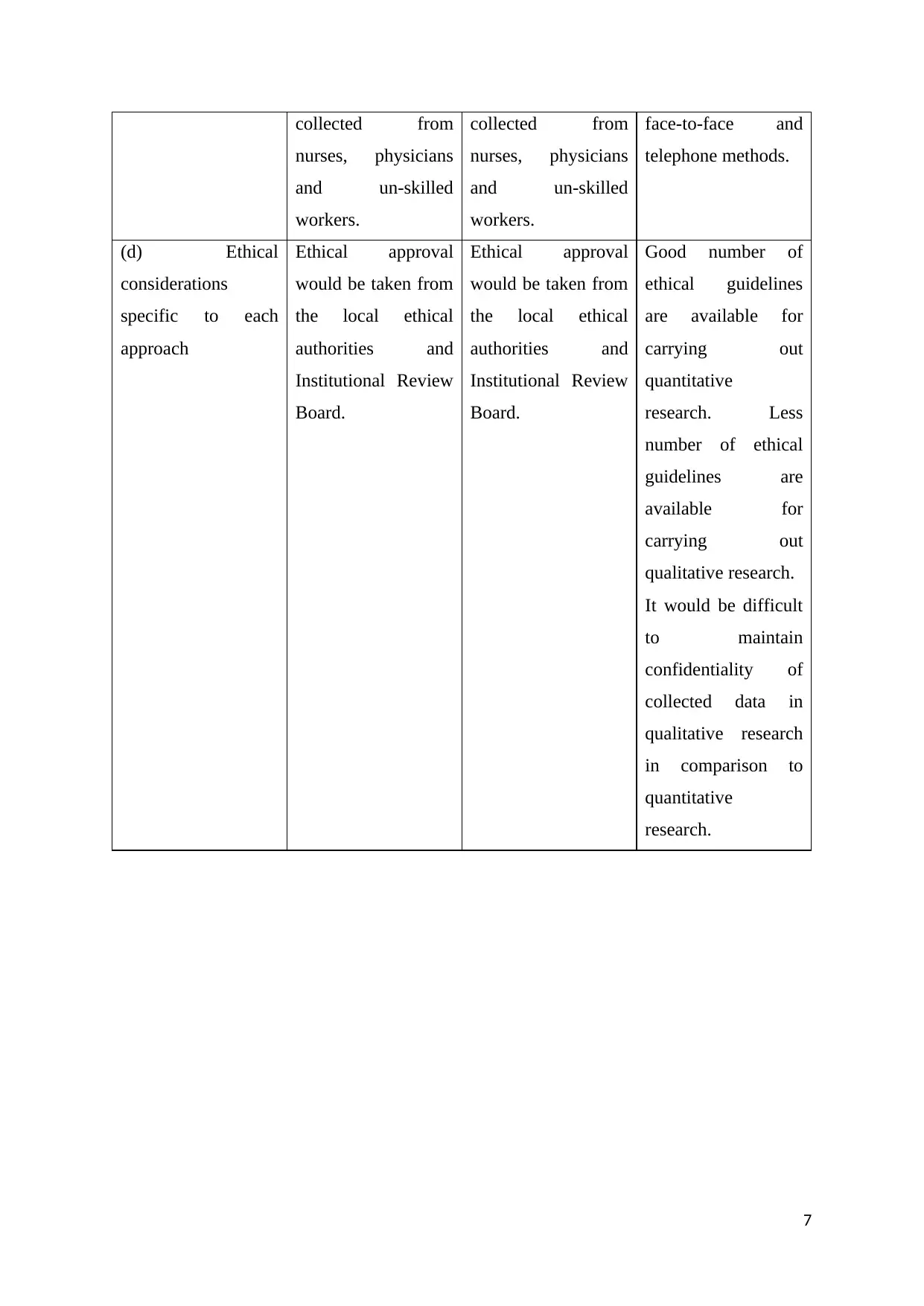
collected from
nurses, physicians
and un-skilled
workers.
collected from
nurses, physicians
and un-skilled
workers.
face-to-face and
telephone methods.
(d) Ethical
considerations
specific to each
approach
Ethical approval
would be taken from
the local ethical
authorities and
Institutional Review
Board.
Ethical approval
would be taken from
the local ethical
authorities and
Institutional Review
Board.
Good number of
ethical guidelines
are available for
carrying out
quantitative
research. Less
number of ethical
guidelines are
available for
carrying out
qualitative research.
It would be difficult
to maintain
confidentiality of
collected data in
qualitative research
in comparison to
quantitative
research.
7
nurses, physicians
and un-skilled
workers.
collected from
nurses, physicians
and un-skilled
workers.
face-to-face and
telephone methods.
(d) Ethical
considerations
specific to each
approach
Ethical approval
would be taken from
the local ethical
authorities and
Institutional Review
Board.
Ethical approval
would be taken from
the local ethical
authorities and
Institutional Review
Board.
Good number of
ethical guidelines
are available for
carrying out
quantitative
research. Less
number of ethical
guidelines are
available for
carrying out
qualitative research.
It would be difficult
to maintain
confidentiality of
collected data in
qualitative research
in comparison to
quantitative
research.
7
Paraphrase This Document
Need a fresh take? Get an instant paraphrase of this document with our AI Paraphraser
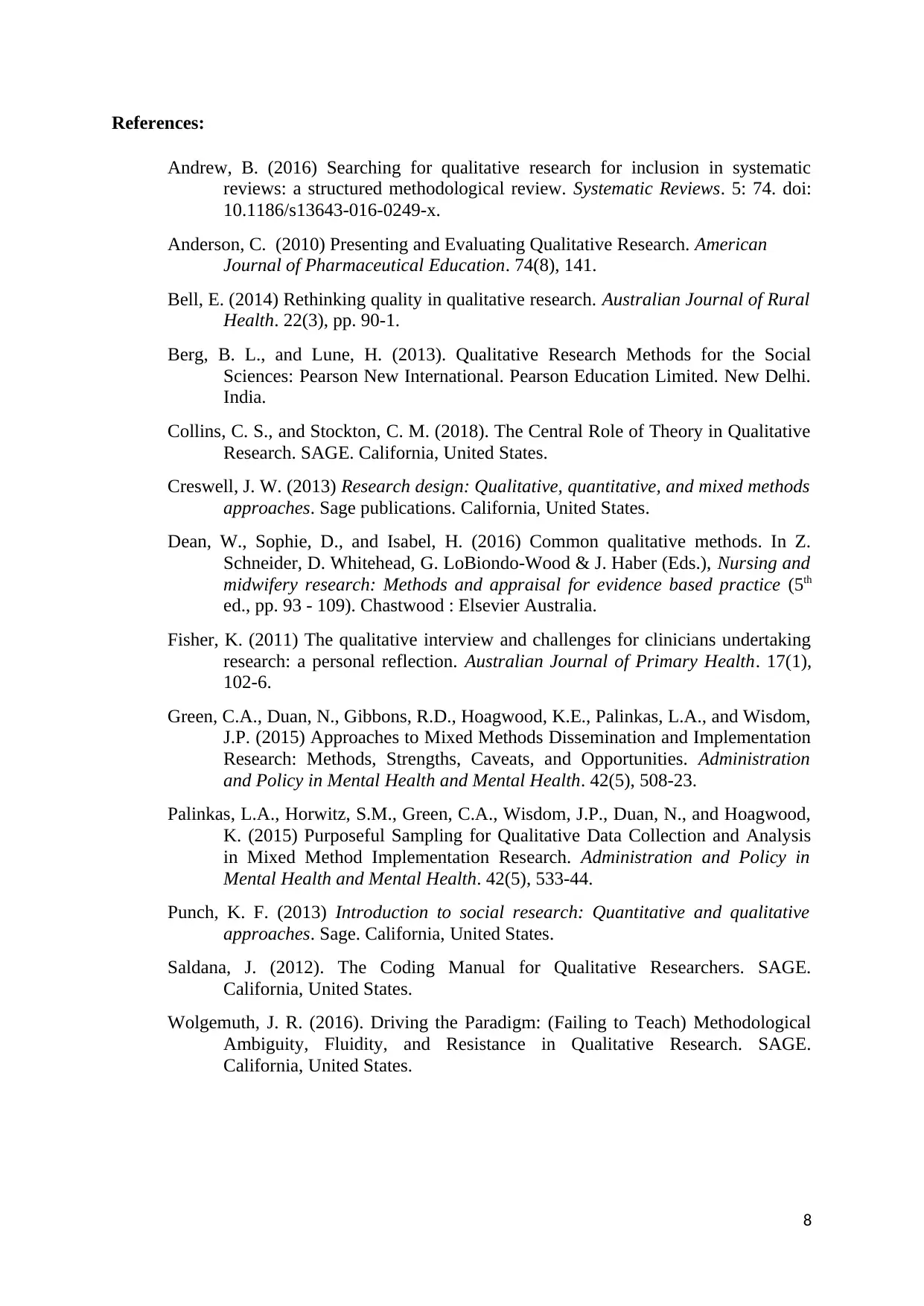
References:
Andrew, B. (2016) Searching for qualitative research for inclusion in systematic
reviews: a structured methodological review. Systematic Reviews. 5: 74. doi:
10.1186/s13643-016-0249-x.
Anderson, C. (2010) Presenting and Evaluating Qualitative Research. American
Journal of Pharmaceutical Education. 74(8), 141.
Bell, E. (2014) Rethinking quality in qualitative research. Australian Journal of Rural
Health. 22(3), pp. 90-1.
Berg, B. L., and Lune, H. (2013). Qualitative Research Methods for the Social
Sciences: Pearson New International. Pearson Education Limited. New Delhi.
India.
Collins, C. S., and Stockton, C. M. (2018). The Central Role of Theory in Qualitative
Research. SAGE. California, United States.
Creswell, J. W. (2013) Research design: Qualitative, quantitative, and mixed methods
approaches. Sage publications. California, United States.
Dean, W., Sophie, D., and Isabel, H. (2016) Common qualitative methods. In Z.
Schneider, D. Whitehead, G. LoBiondo-Wood & J. Haber (Eds.), Nursing and
midwifery research: Methods and appraisal for evidence based practice (5th
ed., pp. 93 - 109). Chastwood : Elsevier Australia.
Fisher, K. (2011) The qualitative interview and challenges for clinicians undertaking
research: a personal reflection. Australian Journal of Primary Health. 17(1),
102-6.
Green, C.A., Duan, N., Gibbons, R.D., Hoagwood, K.E., Palinkas, L.A., and Wisdom,
J.P. (2015) Approaches to Mixed Methods Dissemination and Implementation
Research: Methods, Strengths, Caveats, and Opportunities. Administration
and Policy in Mental Health and Mental Health. 42(5), 508-23.
Palinkas, L.A., Horwitz, S.M., Green, C.A., Wisdom, J.P., Duan, N., and Hoagwood,
K. (2015) Purposeful Sampling for Qualitative Data Collection and Analysis
in Mixed Method Implementation Research. Administration and Policy in
Mental Health and Mental Health. 42(5), 533-44.
Punch, K. F. (2013) Introduction to social research: Quantitative and qualitative
approaches. Sage. California, United States.
Saldana, J. (2012). The Coding Manual for Qualitative Researchers. SAGE.
California, United States.
Wolgemuth, J. R. (2016). Driving the Paradigm: (Failing to Teach) Methodological
Ambiguity, Fluidity, and Resistance in Qualitative Research. SAGE.
California, United States.
8
Andrew, B. (2016) Searching for qualitative research for inclusion in systematic
reviews: a structured methodological review. Systematic Reviews. 5: 74. doi:
10.1186/s13643-016-0249-x.
Anderson, C. (2010) Presenting and Evaluating Qualitative Research. American
Journal of Pharmaceutical Education. 74(8), 141.
Bell, E. (2014) Rethinking quality in qualitative research. Australian Journal of Rural
Health. 22(3), pp. 90-1.
Berg, B. L., and Lune, H. (2013). Qualitative Research Methods for the Social
Sciences: Pearson New International. Pearson Education Limited. New Delhi.
India.
Collins, C. S., and Stockton, C. M. (2018). The Central Role of Theory in Qualitative
Research. SAGE. California, United States.
Creswell, J. W. (2013) Research design: Qualitative, quantitative, and mixed methods
approaches. Sage publications. California, United States.
Dean, W., Sophie, D., and Isabel, H. (2016) Common qualitative methods. In Z.
Schneider, D. Whitehead, G. LoBiondo-Wood & J. Haber (Eds.), Nursing and
midwifery research: Methods and appraisal for evidence based practice (5th
ed., pp. 93 - 109). Chastwood : Elsevier Australia.
Fisher, K. (2011) The qualitative interview and challenges for clinicians undertaking
research: a personal reflection. Australian Journal of Primary Health. 17(1),
102-6.
Green, C.A., Duan, N., Gibbons, R.D., Hoagwood, K.E., Palinkas, L.A., and Wisdom,
J.P. (2015) Approaches to Mixed Methods Dissemination and Implementation
Research: Methods, Strengths, Caveats, and Opportunities. Administration
and Policy in Mental Health and Mental Health. 42(5), 508-23.
Palinkas, L.A., Horwitz, S.M., Green, C.A., Wisdom, J.P., Duan, N., and Hoagwood,
K. (2015) Purposeful Sampling for Qualitative Data Collection and Analysis
in Mixed Method Implementation Research. Administration and Policy in
Mental Health and Mental Health. 42(5), 533-44.
Punch, K. F. (2013) Introduction to social research: Quantitative and qualitative
approaches. Sage. California, United States.
Saldana, J. (2012). The Coding Manual for Qualitative Researchers. SAGE.
California, United States.
Wolgemuth, J. R. (2016). Driving the Paradigm: (Failing to Teach) Methodological
Ambiguity, Fluidity, and Resistance in Qualitative Research. SAGE.
California, United States.
8
1 out of 8
Related Documents
Your All-in-One AI-Powered Toolkit for Academic Success.
+13062052269
info@desklib.com
Available 24*7 on WhatsApp / Email
![[object Object]](/_next/static/media/star-bottom.7253800d.svg)
Unlock your academic potential
Copyright © 2020–2025 A2Z Services. All Rights Reserved. Developed and managed by ZUCOL.





